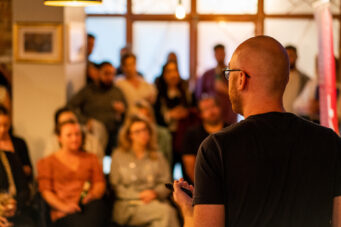
The Media Landscape in Germany
As our media landscapes rapidly evolve to keep up with the volume and breadth of information being shared around the world, organisations are trying to find new ways to keep their audience engaged and attract new ones.
Understanding the media ecosystem of the countries you want to target with campaigns is vital to international PR teams, as without this information you may find campaigns that you thought would take off remaining grounded.
Our series on the different media landscapes you might encounter is designed to help you get a clearer picture of the angles you should be taking in different countries, the media targets to keep in range, and the major players you should keep on your radar.
An overview of the media landscape in Germany
With a population of 83 million people, Germany is one of the top 10 largest countries in Europe. And with German speakers in Austria, Switzerland, parts of Belgium, Liechtenstein, and Luxembourg, German media extends even beyond the borders of Germany itself.
German history has played a huge part in how the media landscape has formed. Until 1990, the country was divided into East and West Germany, each with its own media outlets. The Eastern German media was tightly controlled until the country was unified, under which the broadcasting system became centralised.
As a result, Germany’s media ecosystem remains one of the most traditional in Europe, with most of the country’s media trust being held by newspapers and radio. In 2021, 69% of Germans were using TV as their main source of news, however, online media, including social media, is quickly catching up to this, with a 13% rise in popularity since 2016.
The five most popular online news sites in Germany include:
- ARD News online (Tagesschau is the name of their news show broadcasted several times a day)
- Spiegel online
- t-online
- Focus online
- n-tv.de
Internet coverage is 96% across the country, meaning that the vast majority of the country has access to these platforms. The most popular device to access the news is mobile phones (61%), followed by computers and laptops (49%). But how much trust do the German population put in their media outlets, either traditional or online?
Trust in the media
Over half of the people in Germany consuming news (53%) claim to trust the news that they consume. The highest trust rate for the media lies in their public service broadcasters (PSBs) and local news outlets, such as ‘ARD Tagesschau’ (70%) and ‘ZDF Heute (68%).
The most well-known ‘yellow press’ or tabloid newspaper, ‘Bild’, on the other hand, only has a trust rating of 19% from the German public. In fact, between 2013 and 2021, print media lost 40% of readers, but 26% of those interested in the news still rely on print.
A lot of this decline could be due to the rise in interest in social media as a news outlet, specifically amongst the youth of the population. The country has over 28 million active social media accounts, meaning there is a penetration of 35% of the population through this route.
As a result, PSMs have tried to keep up with the growing interest by making their content accessible through multiple social media platforms, including Twitter, YouTube, and Facebook. (1)
How to create a successful international campaign in Germany
Now that we have a better view of the lay of the land, it’s time to take a look at how we would recommend preparing an international PR campaign for the German market.
Preparation
Failing to prepare is preparing to fail, especially when it comes to international PR campaigns. Before starting your outreach, it’s really important to ensure that you know that your campaign is going to be successful when you outreach, and that means doing some research and preparation beforehand.
You will need to know:
- What topics have been covered by the news and what have people been interested in – you can do this with trending topic tools like Buzzsumo. Using the feeds option, you can select Germany and find the topics that fit best with your upcoming campaigns.
- You can also use keyword research to find out what searches are prevalent in Germany currently – make sure to do this with translated keywords! Ask someone who is fluent in German (Twitter can be a huge help for finding freelancers/a generous helper!) or use online dictionaries such as linguee or leo.org
- What your competitors have been up to in Germany – scan backlinks that competitors have generated and see what content has performed well.
- Think outside the box – you may have to get a bit more creative to find topics that will generate the results you’re looking for, as certain content may perform much better culturally in the UK than it would in Germany.
Now that you have an idea of what to look out for and you’ve got a solid base of ideas and concepts, you can begin to build out your campaign further.
Picking the right tone and topic for your brand
Whether it’s for one of your clients or your own brand that you’d like to introduce in Germany, picking the right tone is vital to ensuring that a campaign lands well in a country that you may be less familiar with.
Culturally, there are formal and informal ways to address people in Germany, so making sure that you find the culturally correct form of address will be essential. Speak to your team to find out if a more formal approach would be better suitable for your topic.
For example, if you’re covering finance or business-related topics, consider using the address ‘höfliche Anrede’. To address someone directly when using more formal speech, you’d use ‘Sehr geehrte/r Frau/Herr (last name)’ or ‘Guten Tag Herr/Frau (last name)’. That translates to ‘Dear Mr/Mrs…’ Using correct terminology in your content, is essential. If you are using a translator, include this in your brief.
In general, Germans are more interested in more serious topics or topics that they can personally relate to, such as finance and business, current and traditional lifestyle topics, and particularly sustainability. Here are some angles you could consider:
- Finance and business: consider a topic surrounding personal finance and keep up to date with the news – maybe a new law has been put into place and you have an expert who could comment.
- Lifestyle: Think about tips that are relevant to Germans, make sure you’re aware of traditions and look out for any newsworthy awareness days – as long as they apply to Germany! A ‘fluffier’ topic may not perform as well as a topic Germans can relate to – campaigns like tips on where to travel to in Germany or the most visited tourist hotspots in Germany are less likely to land for example.
- Sustainability: This is a great topic to pick up, using the seasons for different angles on how to be more sustainable in day-to-day life, sustainable travel, or maybe for tips on how to raise a child more sustainably.
Reaching the right journalists
Finding the correct journalists can be critical to your international campaigns. Finding exactly the right journalist will help your campaign and content to land in exactly the right inbox, so doing the research beforehand will help you immensely.
Don’t shy away from emailing or even calling one journalist from a certain publication and asking for the contact details of the person who may be interested in your content! If you’re not sure what publications to reach out to, see who has previously covered similar topics.
A little tip – if you’re not located in Germany, change your location in your Google setting and more relevant results will show in your search feed.
Finally, find creative ways to include your statistics from your release, either with a well-organised table or a creative illustration. This ensures that the journalists you reach out to are entertained by your content and not overwhelmed by a page of numbers.
Ensure you introduce your content and explain in a short sentence why you are contacting the journalists. Some journalists may have further questions, so offer your help and assistance in your pitch so they know who to get in touch with to keep your campaign in the running for outreach.
Understanding the culture, traditions, and landscape of the country you want to target for international PR campaigns is crucial for success. For further insights into the media landscapes of various countries around the world, check out the international section of the c3 website.
You can also find insights into different industries and PR campaign concepts here, as well as contact details for our native in-house speakers.
- Source: https://reutersinstitute.politics.ox.ac.uk/digital-news-report/2022
